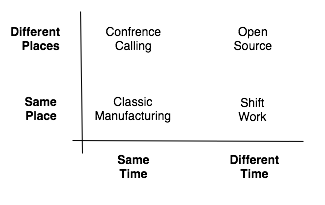There is a surprising syndrome in standards. At first blush standards exist to make help exchange between parties proceed more smoothly. If buyer and seller agree on weights and measures then transactions are simpler. It’s an efficiency argument. Surprisingly there is a countervailing force.
A common, but dangerous, blindness that arises from that simple view of standards. If you thinking about standards that way you become fixated on the efficiency benefits and in turn on the beneficiaries of the efficiencies. Example: why do we drive on the right (or the left)? Obviously because it’s so much more efficient and safe compared to not having a standard; it’s good for the drivers. This makes you blind to the other players in the game. What about the road builders what benefits to they capture?
We have two major sets of standards for weights and measures on the planet. The metric system and the anglo-american system. After the second world war the vast majority of the planet’s economic activity used the anglo-american system. Then and now the switching costs of moving from that standard to the more efficient metric system were huge. The efficiency improvements were minor compared to the huge advantages of having one system. This is a classic “standards war.”
I have come to consider a bit of a mystery why the minority standard – i.e. the metric system – survived and thrived. What what the source of the advocacy for that? I do not believe that parties to exchanges, i.e. those who use the standard, were creating a forceful demand for change. I do not believe that the benefits of switching were even close to the cost of switching. I just do not find it credible that the forces of good overcame the installed base by the virtue of their eloquent arguments. In large part because I find, upon closer examination, that the arguments are thin. They lack sufficient force to drive people over the switching costs.
What was the driving force? Who was driving this change?
Follow the money.
The beneficiaries where the tool vendors. The entire weights and measures industry benefited from the exercise. If they could get the anglo-american system to be changed over to the metric system they would get a share of the switching costs.
The entire boondoggle was driven by a desire to force upgrades in the installed base! Better yet the longer the switch over took (or takes) the longer they can sell two of everything. Two rulers, two scales, two sets of cups and measures. Sure the tool vendors had allies in the science community that were actually seeking efficiencies. They even allies in the education establishment who were looking for things to teach that weren’t controversial. But I can’t convince myself that the allies perceived sufficient near term benefit to be the real drivers.
The tool vendors sell efficiency, but they reap a benefit from volatility, complexity, transition, and change. The result is that almost without exception as standards setting unfolds the players at the table with the clearest understanding of why they will benefit is the vendors of tools (etc.) used to implement the standards. Their motives are not the same as the motives of those the users.
Something to consider next time you encounter a complex standard.

